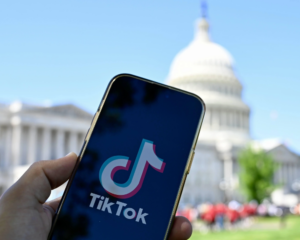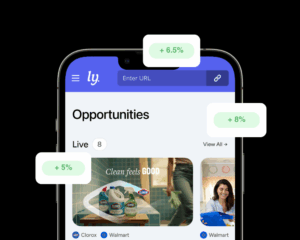Influencer marketing has become an internet buzzword, but what is it exactly? And, how can you use it to make money online?
With influencer marketing, you can get paid to share about products that you already use and love. This guide will break down the nuts and bolts of influencer marketing, offer examples of how it works, and explain how you can get started.
What is Influencer Marketing?
Influencer marketing is a marketing strategy that brands use to get in front of their target audience. Brands partner with social media influencers whose audience demographics meet their target market to share real-life experiences with their products.
For example, a brand may contract an influencer to create a certain amount of posts, stories, or videos about their products. The posts could be reviews, tutorials, unboxing videos, day-in-the-life content, and more. There are other types of influencer marketing as well, which are covered below.
With influencer marketing, the objective is for the influencer to show how they use products in their everyday lives. The content is typically less polished than a commercial or ad because it is authentic.
How Influencer Marketing Builds Social Proof
The purpose of influencer marketing is to build social proof with the brand’s target audience so they are more likely to purchase their products. Social proof is a psychological concept that explains why people tend to copy the behavior of others, especially when it comes to their purchasing decisions.
For example, when someone is considering purchasing a product, they look for positive reviews from others. This is one example of social proof.
Influencer marketing is another powerful way to build social proof because the audience trusts what the influencer has to say. The target audience wants to mimic the influencer’s buying decisions. When influencer marketing is done correctly, the loyalty that an audience feels toward an influencer can be transferred to the brand.
Another reason that influencer marketing works so well is that audiences trust the influencer to be authentic. An influencer can share their real experience with the products, which builds their credibility and trustworthiness. Customers pay attention to influencer reviews because they trust them to be genuine.
What are Examples of Influencer Marketing?
Types of influencer marketing include sponsored posts, product reviews, giveaways, affiliate marketing, and more. The expectations and pay structure may vary with each type.
Sponsored Posts
With a sponsored post, brands pay influencers to create content about their products. For example, a makeup brand may contract a beauty influencer to create makeup tutorial posts using their products.
This is the most common type of influencer marketing. However, it’s important to point out that the influencer gets paid for the content they create, not for any resulting sales of the brand’s products.
Product Reviews
Next, a brand may contract an influencer to do a review of their product. For example, an athletic wear brand may ask a fitness influencer to review their latest clothing line. The influencer is expected to provide honest opinions about the product to their audience. Once again, product reviewers are paid for their content, not for product sales.
Content Giveaways
Another type of influencer marketing content is giveaways. The brand will offer a product that the influencer can give away to their audience. Giveaways are a great way for both the influencer and the brand to grow their following.
Affiliate Marketing
Finally, affiliate marketing is when an influencer has a personalized link or discount code for a product that they share with their followers. When followers use the link or code to purchase a product, the influencer makes a commission off the purchase. In this case, influencers are paid for sales rather than the content they create.
No matter what type of influencer marketing you use, it’s important to track your analytics. This can help you measure whether your posts have been successful. Influencer marketing statistics you might track include the content’s engagement rate, reach and impressions, click-through rate, conversion rate, and return on investment.
A post’s engagement rate measures how many people engage with it through likes, comments, and shares. The conversion rate reports how many people took the desired action of the post. For example, 1,000 people may have engaged with a post, which resulted in 200 people purchasing the product from the post. The conversion rate of the post would be 20 percent.
How Many Followers Do You Need to Be an Influencer?
A common misconception is that you must have a follower count in the hundreds of thousands to be an influencer. More than ever before, brands are engaging with “micro influencers” and “nano influencers,” which are content creators with smaller audiences that are highly engaged.
Micro-influencers typically have between 10,000 and 100,000 followers, while nano influencers have between 1,000 to 10,000 followers. Brands like to work with these influencers because they tend to stick to a niche that matches with the brand’s target audience. They also have highly engaged audiences, which makes them more likely to make purchases based on the influencer’s recommendations. When you work with an influencer marketing platform like Mavely, making money as an influencer is easier than ever.
How to Get Started as an Influencer
To get started as an influencer, you first need to choose a niche that you will post about. Sticking to your niche will help you identify your target audience and draw them to you. For example, your niche could be fashion, makeup, or sustainable living.
Next, post high-quality, visually appealing content within your niche. Create content that is valuable to an audience, such as reviews, so that they begin to trust your opinions. Interact with your audience via comments and messages to keep them engaged.
Once you begin to grow a following, you can start to pitch yourself to brands for influencer marketing campaigns. Using an influencer marketing platform is a great way to find brands that are looking to connect with influencers.
What is the Best Influencer Marketing Platform?
With so many influencer marketing platforms out there, you’re probably wondering which one is the best. When looking at your options, it’s smart to consider what your goals are long term and what your priorities are from a platform. For example, a macro influencer who livestreams video games and wants to run giveaways will have different needs than a micro influencer who wants to educate their audience on sustainable fashion choices.
Mavely is a great marketing platform for micro-influencers and nano influencers who are passionate about growing their community. There is no minimum follower count to get started and you get paid every two weeks, whereas other platforms typically pay influencers every three months. Also, the technology is easy to use and allows you to quickly create links to products you love.
Mavely works with everyday influencers to create content that is relatable, authentic, and engaging. When you use Mavely for your influencer marketing campaigns, it’s easier than ever to connect your target audience to brands you love.
Get Started in Influencer Marketing With Mavely Today
Whether you are brand new to influencing or you already have a loyal audience, Mavely can make your influencer marketing journey easier. With Mavely, you can seamlessly connect with brands and share shoppable SmartLinks with your audience all on one platform.
Influencer marketing is a booming industry, and there’s room for you to make a name for yourself. The best part is that you don’t need millions of followers to be successful as an influencer. Start building your dream influencer marketing career and join Mavely today.







